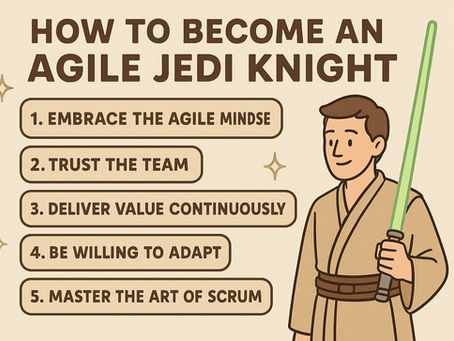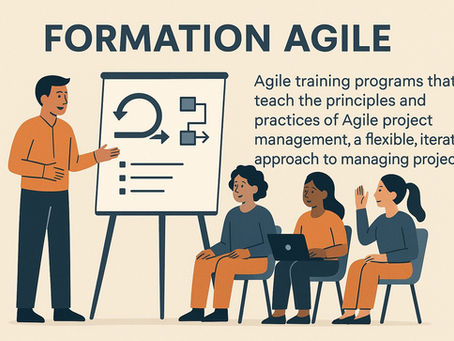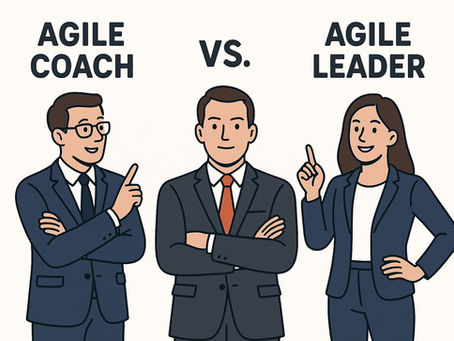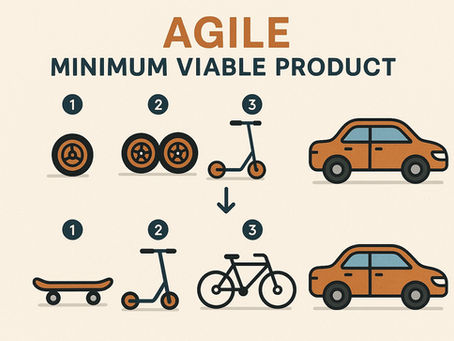top of page
Search


INVEST Criteria in Agile: A Complete Guide
The INVEST criteria provide the foundation for clarity, consistency, and collaboration in large-scale Agile delivery. For enterprises, they are far more than a team-level checklist they are a strategic framework that connects vision to execution. By ensuring that every user story is independent, negotiable, valuable, estimable, small, and testable, organizations enable transparency, accountability, and faster value delivery.

Michelle M
Nov 46 min read


Business Analyst in Agile Methodology: Driving Alignment and Value at Scale
In large enterprises, the Business Analyst in Agile methodology is far more than a supporting role it’s a strategic function that ensures every product increment aligns with organizational goals, delivers measurable value, and meets customer needs.

Michelle M
Nov 46 min read


Be Agile: How to Turn Methodology Into Mindset
To be Agile is to embrace a mindset of continuous evolution. It’s not a process, tool, or framework it’s a philosophy that redefines how large organizations think, lead, and deliver value.

Michelle M
Nov 45 min read


Go Agile: Turning Strategy Into Continuous Delivery
To Go Agile is to embrace change as a constant. It requires courage, leadership, and a clear vision of what agility means at scale. For large enterprises, the journey begins with mindset and continues through structure, technology, and culture. When organizations go Agile successfully, they achieve more than efficiency they build resilience, empower people, and create lasting competitive advantage in an unpredictable world.

Michelle M
Nov 46 min read


Agile Transformation Roadmap: From Vision to Execution
An Agile transformation roadmap is far more than a sequence of steps it is a strategic framework that connects vision with execution. For large enterprises, it provides clarity, governance, and momentum across complex ecosystems. By following a structured roadmap, organizations can transform incrementally while maintaining stability, ensuring that agility becomes a permanent driver of success rather than a temporary initiative.

Michelle M
Nov 45 min read


Agile Methodology Books That Shape Business Agility
Agile methodology books are essential resources for large organizations seeking to build scalable, sustainable, and human-centered agility. They provide the intellectual foundation for every transformation journey, guiding executives, PMOs, coaches, and teams toward better collaboration and value delivery

Michelle M
Nov 47 min read


Agile Fundamentals: The Foundation of Scaled Agile Frameworks
Agile fundamentals are not limited to project execution. They represent a shift in how enterprises think, lead, and deliver value. When organizations embrace Agile principles at every level team, program, and portfolio they create a culture of responsiveness and innovation.

Michelle M
Nov 45 min read


RTE in Agile: How Release Train Engineers Drive Scaled Delivery
The Release Train Engineer (RTE) is one of the most critical roles in large-scale Agile delivery. Acting as the orchestrator of value, the RTE ensures alignment, communication, and continuous improvement across complex enterprise ecosystems.

Michelle M
Nov 36 min read


Agile Workspace Design: Creating Dynamic Agile Environments
Agile workspace design is a catalyst for enterprise transformation. By aligning physical and digital environments with Agile principles, large organizations unlock collaboration, creativity, and speed. The workspace becomes not just a place to work, but a living framework that supports how teams think, connect, and deliver value. In the Agile enterprise, design and agility move hand in hand to create a more human, adaptive, and high-performing organization.

Michelle M
Nov 35 min read


Agile Nearshore: Enhancing Speed and Quality at Scale
Agile nearshore delivery has become a cornerstone of enterprise agility. It combines the flexibility of local collaboration with the efficiency of global resourcing. By embedding nearshore partners within their Agile frameworks, large organizations can accelerate delivery, maintain quality, and scale sustainably.

Michelle M
Nov 35 min read


How Does a Company’s Organizational Structure Impact Project Management Success
Organizational structure is not just a management chart it is the operating system of corporate project management. It dictates how power, information, and accountability flow across the enterprise.

Michelle M
Nov 17 min read


Formation Agile: Empowering Leaders Through Agile Training
A Formation Agile training program is more than a course it is a transformation experience that shapes how professionals and organizations approach work, communication, and leadership. It teaches not only the mechanics of Agile frameworks but also the philosophy that underpins them: collaboration, flexibility, and customer focus.

Michelle M
Oct 287 min read


Project Management vs Scrum Master: Leadership Styles Compared
Both the Project Manager and the Scrum Master play vital roles in modern project execution. While their responsibilities and methodologies differ, their shared goal is delivering successful projects that provide value.

Michelle M
Oct 207 min read


Transformation Glossary: Key Terms and Concepts You Should Know
Transformation has become a central theme in modern organizations, whether it’s digital transformation, cultural transformation, or business transformation. With organizations evolving rapidly, leaders, managers, and employees must be equipped with the right terminology to understand the journey. A transformation glossary provides clarity by defining important terms and frameworks that guide change initiatives.

Michelle M
Aug 265 min read


Scrum Glossary: The Complete Guide
Scrum is one of the most widely used agile frameworks, empowering teams to deliver value iteratively and collaboratively. To fully understand Scrum, it helps to know the essential terms, roles, and artifacts that form its foundation. This Scrum glossary serves as a comprehensive guide, offering clear explanations of over 100 key concepts that every Scrum practitioner, project manager, or agile team member should know.

Michelle M
Aug 256 min read


Agile Glossary: 100 Essential Terms
Agile has transformed the way organizations approach project management, product delivery, and continuous improvement. But with transformation comes terminology. The Agile world is filled with frameworks, roles, ceremonies, and practices that can sometimes feel overwhelming, especially to newcomers.

Michelle M
Aug 246 min read


Scrum vs Waterfall: Which Project Methodology Is Best for You?
In project management, selecting the right methodology can mean the difference between success and failure. Two of the most prominent frameworks Scrum and Waterfall offer fundamentally different approaches to managing and delivering projects. This blog will explore the differences between Scrum and Waterfall in detail, helping you understand when to apply each and how they impact planning, execution, collaboration, and outcomes.

Michelle M
Jul 285 min read


Agile Coach vs Agile Leader: Roles Compared
This blog will explore Agile Coach vs Agile Leader reviewing the similarities, differences, and ideal use cases for Agile Coaches and Agile Leaders. If you're an organization on the brink of Agile transformation, a team member aiming for one of these roles, or an executive trying to understand how to structure your Agile journey, this deep dive will help clarify what each role brings to the table.

Michelle M
Jul 165 min read


Minimum Viable Product Agile: A Detailed Guide
This blog explores these questions in depth, breaking down what an MVP really is, how to design and implement one effectively, and the benefits and challenges involved in its execution. Whether you're a product owner, Agile coach, business stakeholder, or startup founder, understanding MVP in an Agile context can make or break your next product launch.

Michelle M
Jul 155 min read


What Is a Release Train Engineer?
A Release Train Engineer is a servant leader and Agile coach responsible for facilitating Agile Release Trains (ARTs), aligning stakeholders, and ensuring that teams are delivering value continuously and to a high quality standard. Positioned at the heart of the Scaled Agile Framework (SAFe), RTEs guide ARTs through planning, execution, and improvement, helping them navigate complexity and deliver business value on time and at scale. In this blog, we’ll explore the RTE role i

Michelle M
Jul 135 min read
bottom of page
